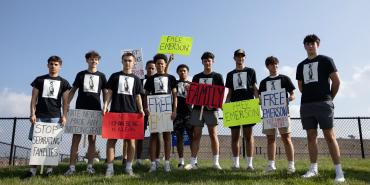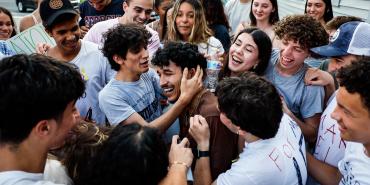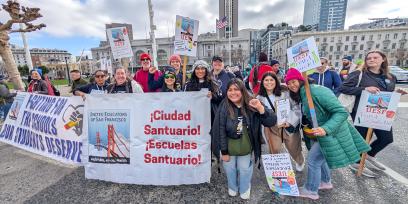When history teacher John Klingler heard that someone from his school had been detained on immigration charges, he assumed it was someone else’s kid. So when he recognized the name, it was a “heart shattering” moment.
The student, Emerson Colindres, had been in Klingler’s 10th-grade history class and graduated from Gilbert A. Dater High School in Cincinnati days before he was detained in June. Klingler describes him as smart, determined and hard-working. He was a star on the soccer field and so dedicated to the sport that Klingler would catch him sneaking peeks at the World Cup during class. Recently, Colindres had returned to Klingler’s classroom to ask for self-improvement book recommendations.
Colindres, who has no criminal record, was detained during a regularly scheduled appointment with Immigration and Customs Enforcement. Klingler joined other teachers, students and community members at the Butler County Jail to protest, hoping to free him. But the young man was transferred to an ICE facility in Louisiana, and on June 18 the newly minted graduate became one of a group of men “handcuffed like we’re some big criminals” on a deportation flight to Honduras, as he described it to The Guardian. Colindres hadn’t lived in Honduras since he was 8 years old.
Not the only one
This sort of deportation—far beyond President Donald Trump’s promise to focus solely on deporting criminals—is happening across the country.
In Milford, Mass., teenager Marcelo Gomes Da Silva was detained on his way to volleyball practice, according to CBS News: Agents had been looking for his father, but they handcuffed him when they realized his visa had expired. Six days later he was released on bond, covered by funds raised by the community.
In Chelsea, Mass., a student and a recent graduate were arrested by ICE: Belizario Vasquez was detained during a scheduled hearing and Geovani De La Cruz Catalan when he was pulled over just days after graduating from Chelsea High School. In Detroit, teenager Maykol Bogoya-Duarte was pulled over on his way to a school field trip, and when police could not communicate with him in Spanish, ICE was called in. He was detained and, despite pleas from the school district to allow him to finish high school, eventually deported to Colombia.
And in New York City, ELLIS Preparatory Academy student Dylan Lopez Contreras was arrested by immigration authorities in early June. He was enrolled in a school designed for older immigrant students and working part-time to support his mother and sisters. The community rose up in protest, and fellow students wrote letters delivered to the detention facility in Pennsylvania where he is being held.
“Our students need to be protected,” said Michael Mulgrew, president of the United Federation of Teachers. “In this case, it appears that a Bronx high school student was taken advantage of and stripped of his legal rights during a court hearing. In New York City, at least, justice and fairness are supposed to be for all, not just the chosen few. Together with immigration and legal advocates, we will fight for justice.”
Big picture
These deportations are just one part of Trump’s attempt at mass deportation across the board.
ICE raids have been on the rise, including in Los Angeles, where massive protests have showed how unpopular these policies are. Some 56,000 people are currently being held by ICE, according to a recent National Public Radio report; about 30,000 of them have no criminal records.
Visiting college students who are here on student visas have been targeted for deportation; even people with green cards have been arrested. Mahmoud Khalil, a recent Columbia University graduate, was snatched by masked officials in New York and remained in a Louisiana detention center for over three months without being formally charged with a crime. He has since returned to his family. Tufts University student Rumeysa Ozturk was handcuffed outside her apartment in the Boston area and kept in the Louisiana facility for six weeks before she was able to return. Both these students were targeted for their activism and protests against the war in Gaza, but other international students and faculty members have had their visas revoked for no apparent reason.
Trump has also used the Alien Enemies Act of 1798 to declare certain immigrants to be gang members at war with the United States and deport them to a prison in El Salvador, without due process. Although a judge issued a restraining order to stop those deportations, the Trump administration defied the courts and continued the deportations.
Temporary Protected Status is also under attack. This humanitarian parole protects immigrants whose countries were destabilized by natural disasters, war, conflicts and other severe hardships. The administration has revoked TPS for people from Afghanistan, Cameroon, Haiti, Honduras, Nepal, Nicaragua and Venezuela, putting over 600,000 people at risk of deportation.
The mass deportation strategies are part of a larger message, says Klingler. “I think there’s a narrative that’s being put out to the public about this being an attempt to get rid of ‘criminals,’ but as Emerson’s case demonstrates, that’s just the rhetoric that’s used to whip up support for these mass deportations,” he says. “In reality, it’s not about getting rid of criminals. It’s about getting rid of immigrants in general.”
And Klingler believes the movement threatens American citizens as well. “The immigrants are being punished as a way to discipline the rest of us,” a way to say, “Stay in line or this could happen to you.” Mass deportation is “a way to keep people in fear.”
Fighting back
The AFT and its affiliates have been deeply involved in supporting the immigrant community, holding Know Your Rights sessions and citizenship clinics, and providing resources to keep people safe and keep families together. We work closely with advocacy organizations like United We Dream, the National Immigration Law Center, the Labor Council for Latin American Advancement, the Center for Law and Social Policy, the National Newcomer Network, Kids in Need of Defense, UnidosUS, the League of United Latin American Citizens, the UndocuBlack Network, the National Korean American Service and Education Consortium, and others to influence policy at the national level as well.
We also maintain a deep collection of educator resources on Share My Lesson and Colorín Colorado to teach children about immigration and to support professional development for English as a second language teachers and others who work with immigrant children.
Why would a union be involved in immigration issues? Because so many of the people we work with—students, families, patients in healthcare facilities, clients in public settings—are connected to newcomers to this country and face challenges regarding language, custom and legal status. And some of our own members are directly impacted by the shifts of immigration policy: The AFT represents Deferred Action for Childhood Arrivals recipients, TPS holders, visa holders and some members who live in mixed immigration status households. The AFT’s FAQ on immigration serves as a great backgrounder for individuals interested in learning more about the various threats to immigrant communities and opportunities to fight back and support our students, patients and their families.
“Unions in general have a responsibility to stand up for movements for justice, especially when it touches our students,” says Klingler, who is a member of the Cincinnati Federation of Teachers.
[Virginia Myers]



